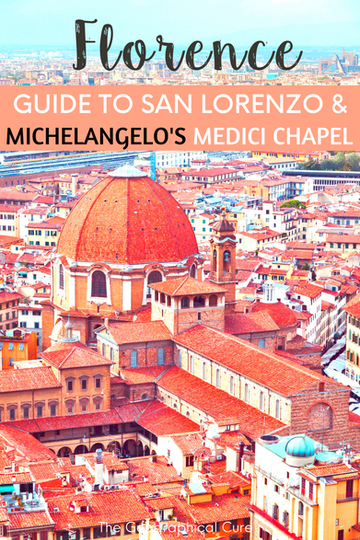Here’s my complete guide to the Basilica of San Lorenzo in Florence Italy.
I tell you everything to see inside and give you must know tips for visiting and getting tickets.
The San Lorenzo complex is vast. It includes the basilica itself, Brunelleschi’s Old Sacristy, the Medici Chapels, the Medici Crypt, and the Laurentian Library.
The complex is a veritable haven of Renaissance art and architecture.
Most importantly? It has the largest number of Michelangelo sculptures in Florence, quite a selling point.
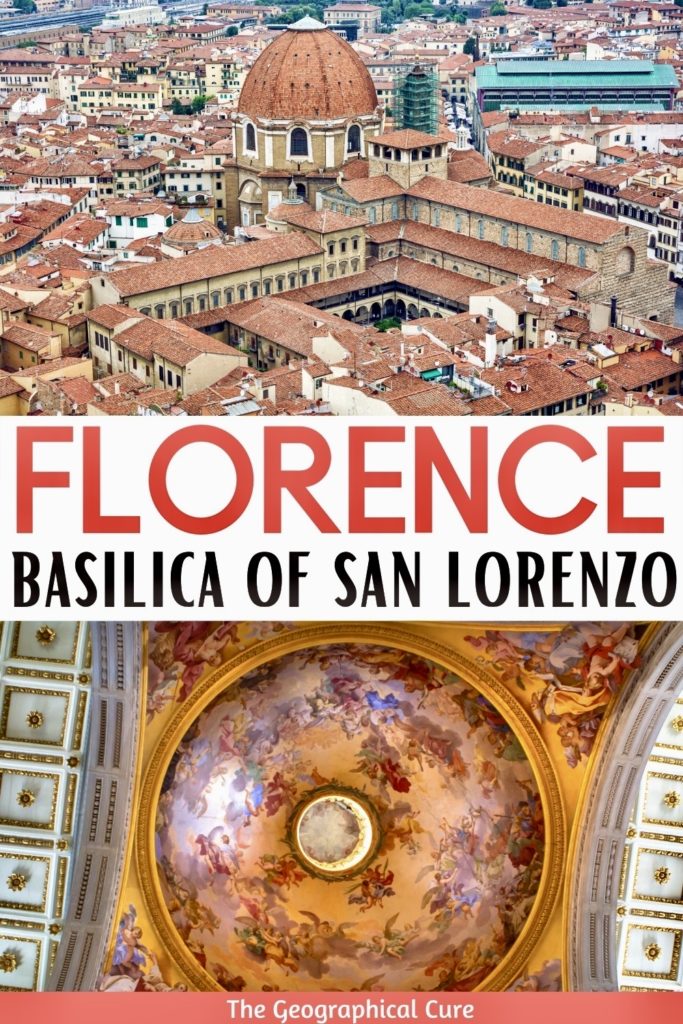
You’ll also find a Michelangelo-designed library. If you’re on the Michelangelo trail, the Medici Chapels and the Laurentian Library are must see sites in Florence.
The Basilica of San Lorenzo was the official parish church of the Medici family. The Medici were a wealthy and powerful banking family who ruled Florence for nearly three centuries.
The Medici’s history is intertwined with the history of Florence, San Lorenzo, and the Renaissance.
READ: Guide To Florence’s Medici Palaces
History & Design of the Basilica of San Lorenzo
In 1421, Cosimo de Medici the Elder commissioned Filippino Brunelleschi (architect of Florence Cathedral’s magnificent dome) to create a design for the Basilica of San Lorenzo.
But then 20 years of political strife and financial difficulties followed. Building didn’t begin until 1442.
READ: Guide To Visiting the Duomo
San Lorenzo’s facade was (and is) raw brownstone. It was meant to be “frosted” with marble facing like Florence’s other beautiful churches.
In 1516, Michelangelo won a competition for the design of the facade of San Lorenzo. The artist spent two years quarrying the finest Carrera marble.
But, in 1520, the facade project was cancelled. The church facade remains unfinished today.
But don’t like the rustic brick facade fool you. The real treasures lie within.
Brunelleschi’s design was groundbreaking and helped usher in the early Renaissance. For the first time in a 1000 years, Brunelleschi used a design inspired by ancient Rome called “modular system promotion.”
That means the church was designed with geometric forms, like circles and squares, that were all interrelated. Brunelleschi used light materials, like white stucco and gray sandstone known as “pietra serena” (a stone that could be cut with precision).
The effect is more minimalist and modern than the previously prevailing Gothic architecture, with an airy feel. There’s not much decoration in the church. Brunelleschi believed the architecture itself was the art. But there are a few things to admire.
Guide To The San Lorenzo Complex: What To See
There’s so much to see at San Lorenzo! To see everything, you’ll need several tickets as I describe below. But it’s worth the price of the tickets.
Aside from the basilica itself, there are five other things to see: the Old Sacristy, the New Sacristy, the Chapel of the Princes, the Crypt, and the Laurentian Library in the cloisters.
Let’s take a tour of all the amazing San Lorenzo sites. It’s one of the best things to do in Florence.
1. Tomb of Cosimo The Elder
In front of the altar, there’s a round porphyry plate on the floor encircled in white marble. On each side of the plate there are copper medallions caved by Andrea del Verrocchio, Leonardo da Vinci’s teacher.
The tomb of Cosimo the Elder lies directly beneath the plate.
READ: Guide To Leonardo da Vinci’s Paintings
2. Donatello Pulpits
The other important must see Renaissance items in the basilica are Donatello’s two bronze pulpits in the nave with bas relief sculpture, the Resurrection Pulpit and the Passion Pulpit. The latter is the most significant.
The Passion Pulpit features New Testament images of the life and passion of Christ. Donatello completed these at the very end of his life.
The next generation of sculptures criticized them. But art historians still love them for the intensity of emotion depicted.
READ: Guide To Donatello’s Greatest Art Works
3. Bronzino Painting
One painting that you shouldn’t miss, in the left aisle, is the Martyrdom of Saint Lawrence by late Renaissance artist Bronzino. Bronzino’s painting tells a gory tale of San Lorenzo’s patron saint, Saint Lawrence.
Naked bodies abound. But typical of the Counter-Reformation late Renaissance period, everything is tidily covered up.
Lawrence was a man who boldly defied authority. After Pope Sixtus II was arrested by Emperor Valerian, Lawrence was asked to bring forward all of the church’s treasures in 3 days.
With that time gap, he instead distributed the precious bits to Rome’s Christian citizens.
4. Brunelleschi’s Old Sacristy
The Old Sacristy is attached to the southern end of the church, accessed off the left transept. It was designed by Brunelleschi in 1419 and completed in 1429.
It’s one of the world’s most famous sacristies and considered the first truly Renaissance building in history. Now, that’s quite an accolade.
A sacristy is a room reserved exclusively for the use of priests. The priests used it to prepare and dress for mass and kept their sacred items there. You could think of it as a sort of priests’ “locker room.”
The Old Sacristy has a square footprint, off which projects a square apse. An umbrella dome covers the sacristy.
It’s composed of 12 vaults joined together at the center, a common method at the time. What was new is the way the dome was deftly integrated in the space below.
Brunelleschi also used fluted pilasters, Corinthian columns, and rounded circular arches. There are a rhythmic system of pilasters.
The pilasters aren’t real or structural. They’re just for looks, a new method introduced by Brunelleschi.
The decorative elements in the Old Sacristy were courtesy of Donatello. He designed the tondos, the lunettes, the reliefs above the doors, and the fine bronze doors themselves.
One thing not to miss in the sacristy is Andrea del Verrocchio’s Tomb for Piero de Medici. It’s an understated tomb set inside an arch space.
It’s made of white marble and porphyry, with an elaborate intertwine grate and elaborate arch device.
5. Michelangelo’s New Sacristy
Michelangelo’s New Sacristy is a beautiful Renaissance space. It can’t be accessed from inside the basilica. You’ve got to buy a separate timed entry ticket for the Medici Chapels.
In 1519, Lorenzo de’ Medici, Duke of Urbino, died at age 26. In June, Giulio de’ Medici, again acting for the Pope, commissioned Michelangelo to construct burial chapels for the Medici.
Fortunately, most of the marble originally intended for the basilica facade made its way inside.
There were supposed to be four monumental Medici tombs. But Michelangelo only finished two for the pope’s brother and nephew, Giuliano and Lorenzo, who were relatively unimportant Medici.
The New Sacristy is a unique monument. It’s an architectural space that was both designed and decorated by a single artist. Michelangelo may have intended to paint the frescos as well. But they were never begun.
READ: The Michelangelo Guide To Florence
The space is much taller than it is long. Michelangelo added another layer of height compared to Brunelleschi’s Old Sacristy. The architecture is peculiar.
There are many closed windows, which make the space somewhat claustrophobic. Michelangelo may have intended to conjure visions of purgatory.
The chapel’s coffered dome is similar to Rome’s Pantheon. The walls are clad with pink green, gold, and white marble.
Getting the lighting just perfect was important to Michelangelo. Light pours in from in the cupola lantern, from the windows, and from a large window at the south side.
The light is symbolic. It was intended to exalt pathos, unify the elements, and light up the tomb sculptures at the times of day they represented.
There are 6 tomb sculptures carved by Michelangelo.
Four are allegories of the passage of time. They were intended to convey the message that time destroys everything earthly, that the days of our lives ineluctably lead to our death.
On the tomb of Lorenzo, the effigy of Lorenzo is shown at the top as a brooding introvert, whose face remains in shadow. Below him are the sculptures of Dawn and Dusk. Dawn suggests the emergence of light. Dusk suggests twilight.
On the tomb of Giuliano, Giuliano’s effigy shows him as an extrovert. This is a beautiful sculpture.
It’s one of Michelangelo’s most idealized pieces. I mean, just look at the long elegant neck. The two tomb statues below are allegories of Night and Day.
Night is regarded as one of Michelangelo’s finest works. The sculpture was based on a classical drawing of Leda.
There’s no doubt who she is because of the owl and bag of poppies. She’s also the only sleeping sculpture.
6. The Chapel Of The Princes
The Chapel of the Princes is the main mausoleum for the Medici Family. Cosimo I commissioned it in 1568. But construction only began in 1602.
The chapel walls are clad with polychrome marble and precious stones. No area is left undecorated.
The Medici intended to cover the cupola with lapis lazuli. But that never came to fruition. Instead, the dome features a fresco by Pietro Benvenuti.
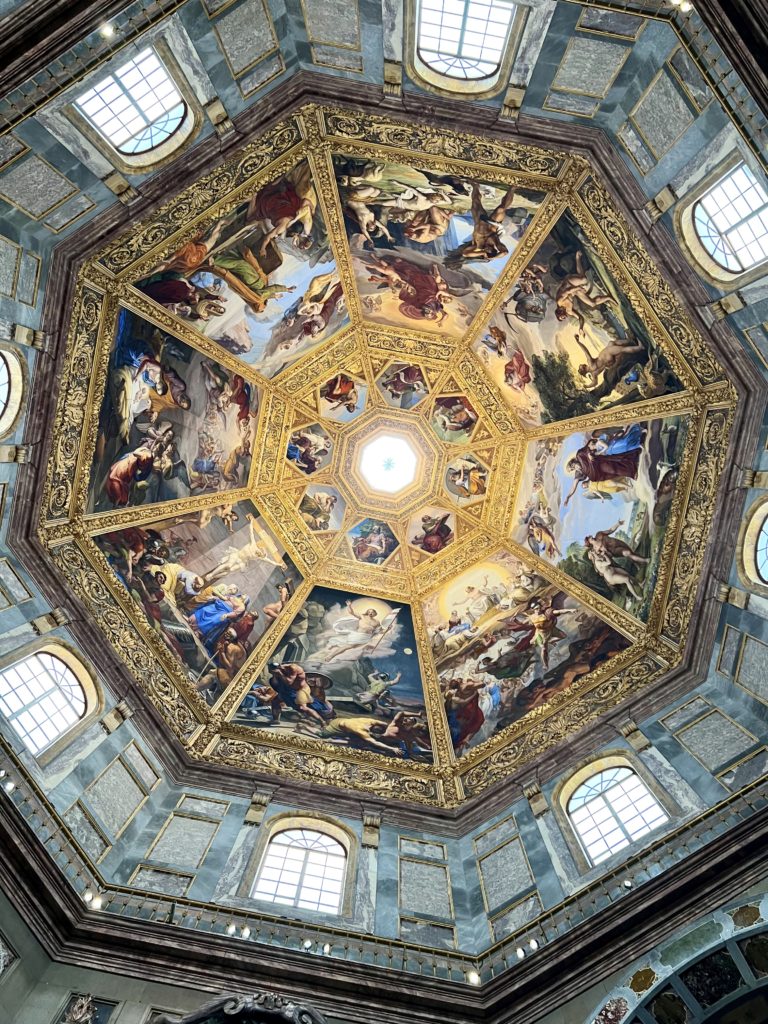
The High Renaissance chapel stands in sharp contrast to the minimalist ethic of the Brunelleschi basilica and Old Sacristy. But the Medici loved it, using the chapel as a reception room.
7. Crypt of San Lorenzo
The crypt is accessed from the cloisters to the north of the church. It holds the graves of two Renaissance luminaries — Cosimo de Medici and Donatello.
Cosimo is in a large sarcophagus built into the central pillar. At Cosimo’s request, his favorite sculptor and friend Donatello was also buried there.
8. Michelangelo’s Laurentian Library
The Laurentian Library consists of a reading room and a 48 foot vestibule built atop the San Lorenzo cloisters. It has one of the world’s most important collections of manuscripts, which belonged to the Medici family. It now functions as a museum, not a library.
Pope Clement VII commissioned Michelangelo to design the Laurentian Library in 1523. Michelangelo supervised the work from 1523-34. When he moved back to Rome, artist and art historian, Giorgio Vasari continued the work.
The Laurentian Library is a revolutionary and blissfully uncrowded masterpiece.
In designing the library, Michelangelo broke away from classical tradition and rules of proportion. He designed a space with curves and unusual configurations that subverted classical forms.
You enter the library from the cloisters of the Basilica of San Lorenzo. The seemingly oversize Triple Staircase that greets you conveys a sense of movement. The staircase seems to pour forward like pools of liquid.
It may be the first freestanding staircase in architectural history. Michelangelo originally intended the staircase to be made out of walnut. But inside it’s made of the same pietra serena used by Brunelleschi.
Wild structures surround the staircase. You almost don’t see the walls. They’re decorated with architectural elements such as extremely large low-hanging brackets and closed windows that taper down.
Some of the elements are put into niches, serving no purpose. Freestanding columns are set into the wall or appear to rest on the corbels. Michelangelo effectively frames architecture as artwork.
Unlike the vestibule, the Reading Room develops horizontally. There are two series of wooden benches, called plutei.
There’s a white and red terra cotta floor and a coffered ceiling. The fine lime wood ceiling was designed by Michelangelo and carved by Giovan Battista del Tasso.
Michelangelo’s dramatic and inventive architectural style marked the beginning of Mannerism, a late Renaissance period that reinvented and put a stylized twist on classicism.
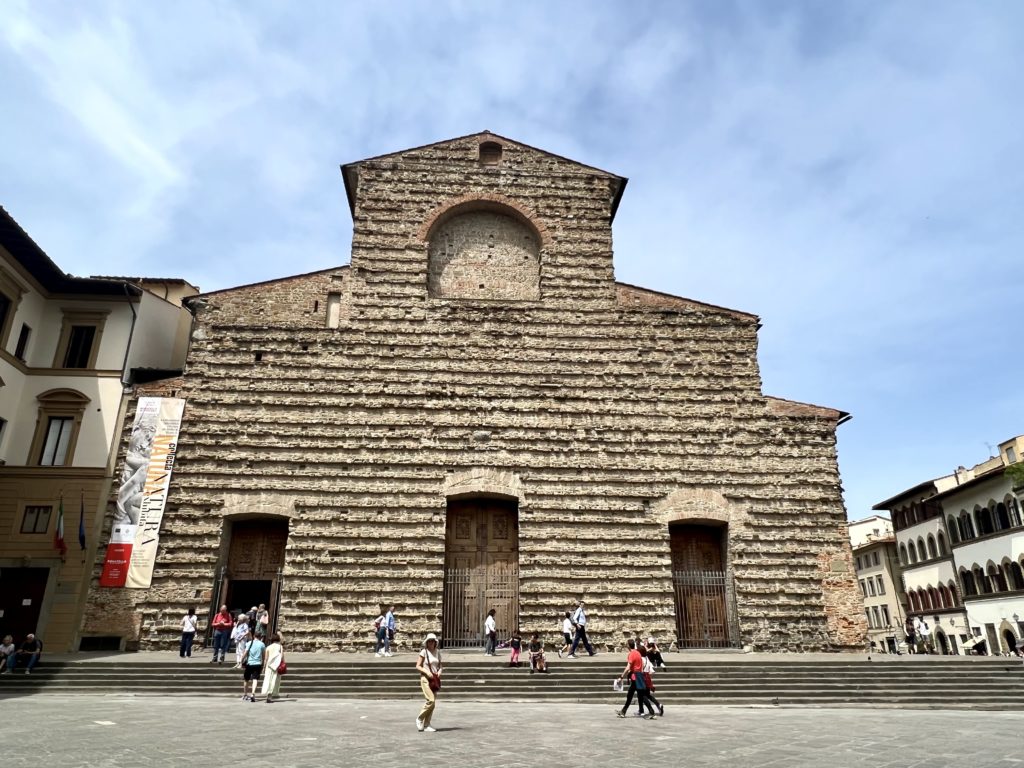
Practical Guide & Tips for Visiting the Basilica of San Lorenzo Complex
Now, down to the nitty gritty of visiting these magnificent San Lorenzo attractions.
I tell you everything you need to know about visiting the Basilica of San Lorenzo, the Medici Chapels, and the Laurentian Library, including how to get tickets and what specific sites the tickets cover.
It’s important to note that entrance to the Medici Chapels is completely separate.
You can’t buy a combination ticket that includes the Medici Chapels, which is an independent state museum.
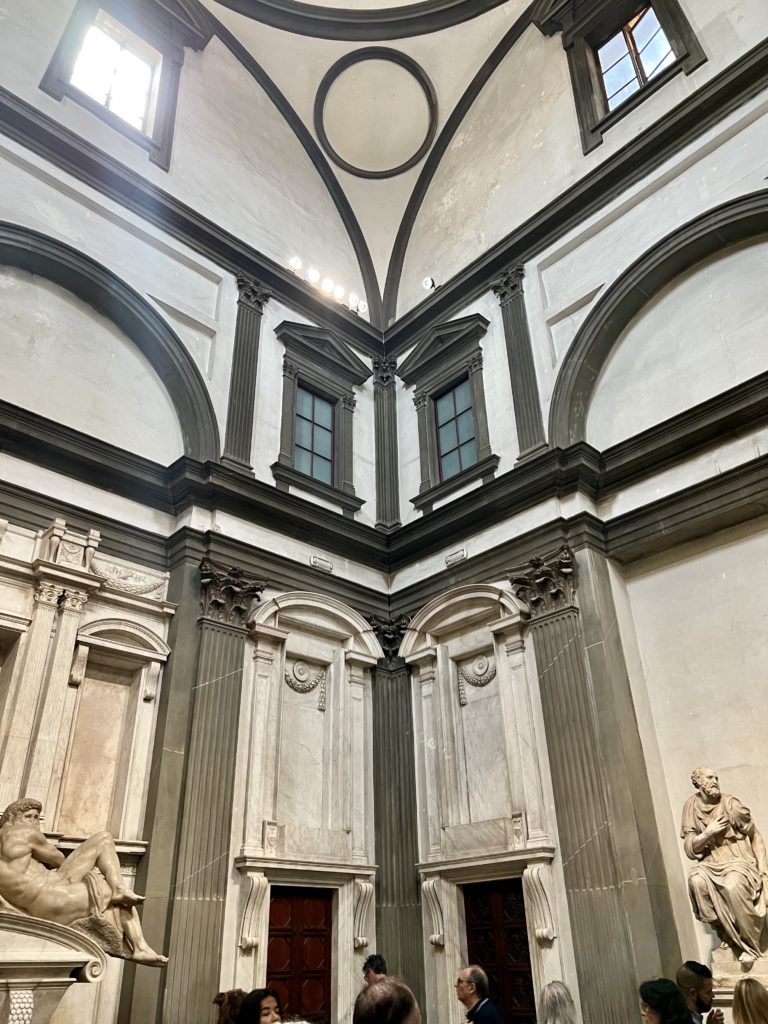
1. San Lorenzo Basilica
Address: Piazza di San Lorenzo 9
Hours:
The basilica is open Monday to Saturday from 10:00 am to 3:30 pm. The church is closed for tourist visits on Sunday (but sometimes open in the afternoon in summer).
Despite it’s opening hours, it may still be closed if a service is in process.
Entry fee:
Admission to the basilica and crypt is € 7. A combination ticket with the library is € 9.50. Click here to purchase skip the line tickets.
The Florence Museum Card is accepted and gives you skip the line access. Click here to purchase.
2. Medici Chapels Museum
Address: Piazza di Madonna degli Aldobrandini 6, at the northeast side of the basilica.
Hours:
The Medici Chapels are open Tuesday through Saturday from 8:15 am to 11:50 pm, closing at 2:50 from April to September. Take note of the early closing time when planning your visit.
Entry fee: € 9. You’ll need to pre-book a timed entry ticket. The lines are long and there are separate lines for half hour slots.
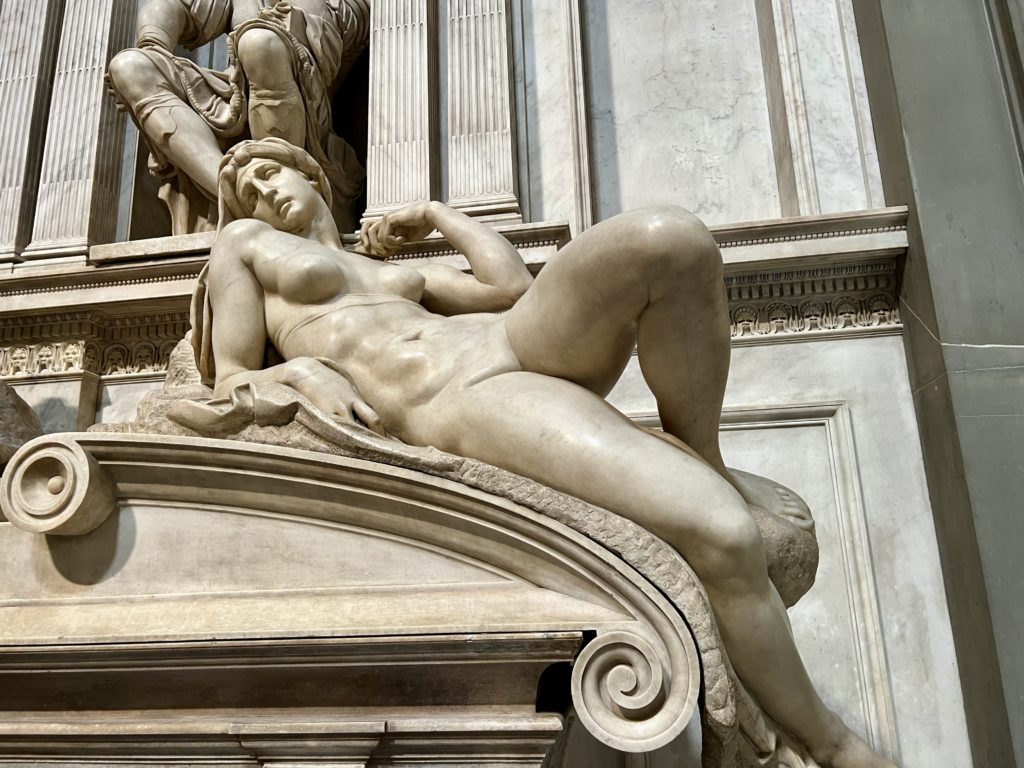
Click here to purchase a ticket for a time slot. These fill up fast, so don’t delay.
You can also book a guided tour of the chapels. This isn’t a bad idea because there is not much explanatory signage.
What does the Medici Chapel ticket include?
A ticket for the Medici Chapels gives you access to the New Sacristy, the Chapel of the Princes, and the Medici Crypt.
It does not give you access to the basilica. You need two separate tickets to visit everything in the San Lorenzo complex.
3. Laurentian Library
Address: Piazza San Lorenzo 9. The library is in the cloisters of San Lorenzo. The entrance is to the left of the church when facing the unfinished facade.
Hours: The library is open weekdays from 9:30 am to 1:30 pm. Take note of the early closing time when visiting the San Lorenzo complex.
Entry fee: € 4. Tickets are sold in the San Lorenzo cloisters or you can buy them online here.
The Laurentian Library is a bit of a hidden gem in Florence, so you likely don’t need skip the line tickets. A combination ticket with the library is € 9.50.
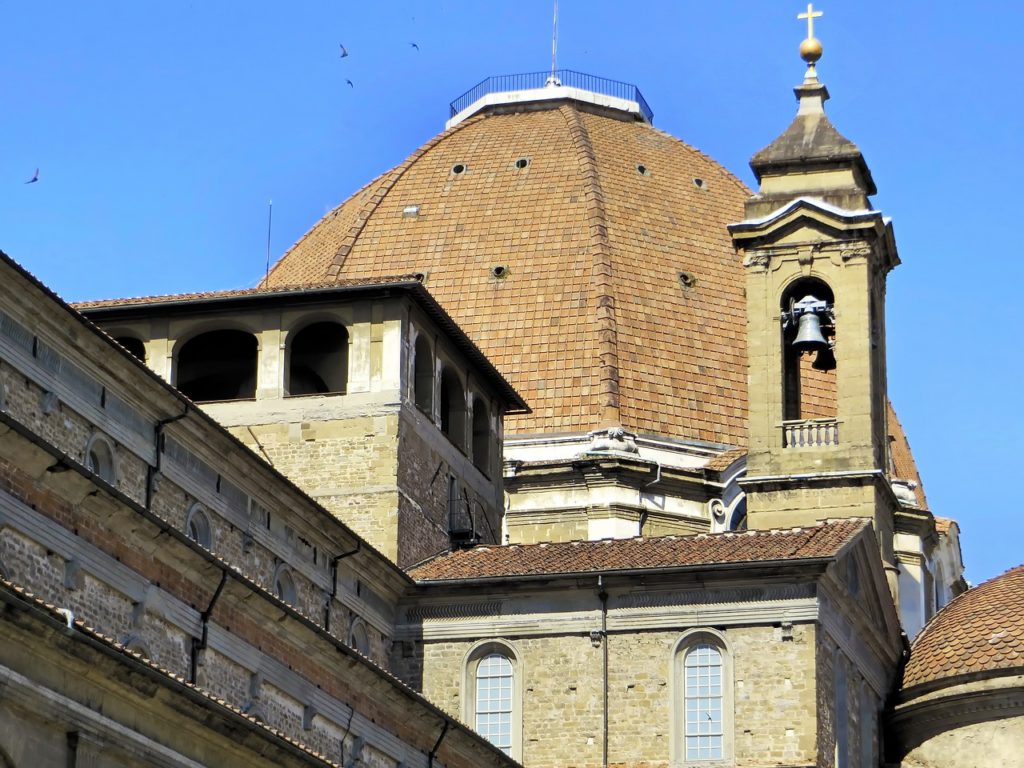
I hope you’ve enjoyed my guide to the Basilica of San Lorenzo. You may enjoy these other Florence travel guides and itineraries.
- 1 Day Itinerary for Florence
- 3 Day Itinerary for Florence
- Best Museums in Florence
- Guide to the Uffizi Gallery
- Best Viewpoints in Florence
- Guide to the Bargello Museum
- The Last Supper Paintings of Renaissance Italy
- Guide to the Statues of the Piazza della Signoria
- Guide to the Palazzo Vecchio
- Guide to the Basilica of Santa Croce
- How To Skip the Line To See Michelangelo’s David
If you need a guide for the Basilica of San Lorenzo in Florence, pin it for later.

